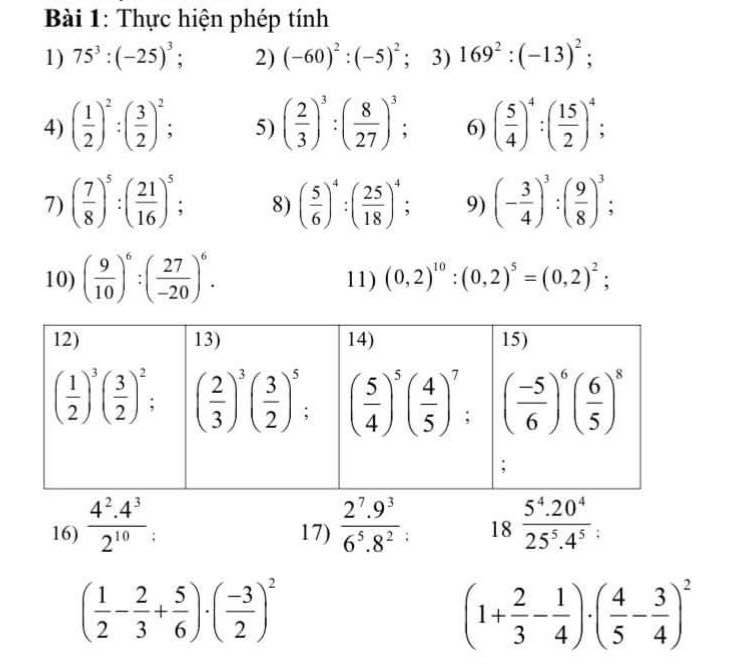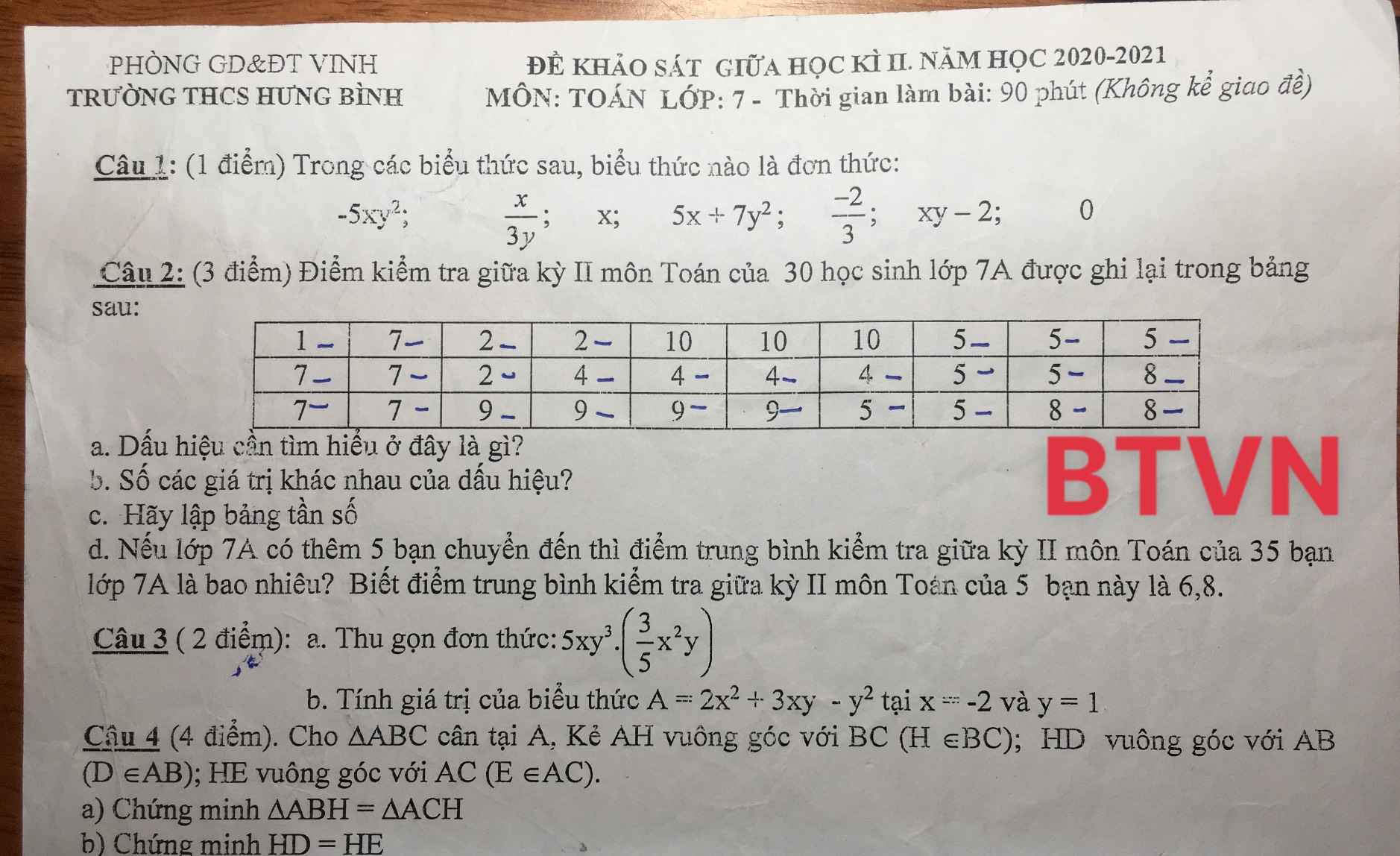
Hãy nhập câu hỏi của bạn vào đây, nếu là tài khoản VIP, bạn sẽ được ưu tiên trả lời.


1: \(75^3:\left(-25\right)^3=\left(\dfrac{75}{-25}\right)^3=\left(-3\right)^3=-27\)
2: \(\left(-60\right)^2:\left(-5\right)^2=\dfrac{60^2}{5^2}=12^2=144\)
3: \(169^2:\left(-13\right)^2=\dfrac{169^2}{13^2}=\left(\dfrac{169}{13}\right)^2=13^2=169\)
4: \(\left(\dfrac{1}{2}\right)^2:\left(\dfrac{3}{2}\right)^2=\left(\dfrac{1}{2}:\dfrac{3}{2}\right)^2=\left(\dfrac{1}{3}\right)^2=\dfrac{1}{9}\)
5: \(\left(\dfrac{2}{3}\right)^3:\left(\dfrac{8}{27}\right)^3=\left(\dfrac{2}{3}:\dfrac{8}{27}\right)^3=\left(\dfrac{2}{3}\cdot\dfrac{27}{8}\right)^3=\left(\dfrac{9}{4}\right)^3=\dfrac{729}{64}\)
6: \(\left(\dfrac{5}{4}\right)^4:\left(\dfrac{15}{2}\right)^4=\left(\dfrac{5}{4}:\dfrac{15}{2}\right)^4=\left(\dfrac{5}{4}\cdot\dfrac{2}{15}\right)^4=\left(\dfrac{1}{6}\right)^4=\dfrac{1}{1296}\)
7: \(\left(\dfrac{7}{8}\right)^5:\left(\dfrac{21}{16}\right)^5\)
\(=\left(\dfrac{7}{8}:\dfrac{21}{16}\right)^5\)
\(=\left(\dfrac{7}{8}\cdot\dfrac{16}{21}\right)^5=\left(\dfrac{2}{3}\right)^5=\dfrac{32}{243}\)
8: \(\left(\dfrac{5}{6}\right)^4:\left(\dfrac{25}{18}\right)^4=\left(\dfrac{5}{6}:\dfrac{25}{18}\right)^4=\left(\dfrac{5}{6}\cdot\dfrac{18}{25}\right)^4=\left(\dfrac{3}{5}\right)^4=\dfrac{81}{625}\)
9:
\(\left(-\dfrac{3}{4}\right)^3:\left(\dfrac{9}{8}\right)^3=\left(-\dfrac{3}{4}:\dfrac{9}{8}\right)^3=\left(-\dfrac{3}{4}\cdot\dfrac{8}{9}\right)^3\)
\(=\left(-\dfrac{2}{3}\right)^3=-\dfrac{8}{27}\)
10:
\(\left(\dfrac{9}{10}\right)^6:\left(\dfrac{27}{-20}\right)^6=\left(\dfrac{9}{10}:\dfrac{-27}{20}\right)^6\)
\(=\left(\dfrac{9}{10}\cdot\dfrac{20}{-27}\right)^6=\left(-\dfrac{2}{3}\right)^6=\dfrac{64}{729}\)

Câu 4:
a: Xét ΔABH vuông tại H và ΔACH vuông tại H có
AB=AC
AH chung
Do đó: ΔABH=ΔACH
b: Xét ΔADH vuông tại D và ΔAEH vuông tại E có
AH chung
\(\widehat{DAH}=\widehat{EAH}\)
Do đó: ΔADH=ΔAEH
Suy ra:HD=HE

\(\left(2x+1\right)\left(x^2-x\right)+x\left(5+x-2x^2\right)=3x+7\)
\(2x^3-2x^2+x^2-x+5x+x^2-2x^3=3x+7\)
\(5x-x=3x+7\)
\(4x-3x=7\)
\(x=7\)
(2x+1)(x^2-x)+x(-2x^2+x+5)=3x+7
=>2x^3-2x^2+x^2-x-2x^3+x^2+5x=3x+7
=>-x^2-x+x^2+5x=3x+7
=>4x=3x+7
=>x=7

\(\left(2x-3\right)\cdot4,8=\left(3x+1\right)\cdot\left(-2,4\right)\)
\(9,6x-14,4=-7,2x-2,4\)
\(9,6x+7,2x=14,4-2,4\)
\(16,8x=12\)
\(x=\dfrac{12}{16,8}=\dfrac{5}{7}\)


a) \(3^{x+1}=9^x\)
\(\Rightarrow3^{x+1}=\left(3.3\right)^x\)
\(\Rightarrow3^{x+1}=3^{3x}\)
\(\Rightarrow x+1=3x\)
\(\Rightarrow3x-x=2x=1\)
\(\Rightarrow x=1\)
b) \(2^{3x+2}=4^{x+5}\)
\(2^{3x+2}=\left(2.2\right)^{x+5}\)
\(\Rightarrow2^{3x+2}=2^{2\left(x+5\right)}=2^{2x+10}\)
\(\Rightarrow3x+2=2x+10\Rightarrow3x+2=2x+2+8\)
\(\Rightarrow3x=2x+8\Rightarrow3x-2x=8\)
\(\Rightarrow1x=8\Rightarrow x=8\)

`3x-15/(5*8)-15/(8*11)-15/(11*14)-...-15/(47*50)=2 1/10`
`3x-(15/(5*8)+15/(8*11)+15/(11*14)+...+15/(47*50))=21/10`
`3x-5(3/(5*8)+3/(8*11)+3/(11*14)+...+3/(47*50))=21/10`
`3x-5(1/5-1/8+1/8-1/11+1/11-1/14+...+1/47-1/50)=21/10`
`3x-5(1/5-1/50)=21/10`
`3x-5*9/50=21/10`
`3x-9/10=21/10`
`3x=21/10+9/10`
`3x=3`
`x=1`

a: Xét ΔABD và ΔAMD có
AB=AM
\(\widehat{BAD}=\widehat{MAD}\)
AD chung
Do đó: ΔABD=ΔAMD
b: Ta có: ΔABD=ΔAMD
=>DB=DM
=>ΔDBM cân tại D
c: Ta có: AB=AM
=>A nằm trên đường trung trực của BM(1)
Ta có: DB=DM
=>D nằm trên đường trung trực của BM(2)
Từ (1) và (2) suy ra AD là đường trung trực của BM






Giả sử phân số \(\dfrac{n-4}{3n-11}\) không là phân số tối giản với \(n\) nguyên.
Khi đó, tồn tại số \(k\) nguyên khác 0 sao cho: \(n-4=k\left(3n-11\right)\)
\(\Leftrightarrow n-4=3nk-11k\)
\(\Leftrightarrow n-3nk=4-11k\)
\(\Leftrightarrow\left(1-3k\right)n=4-11k\)
\(\Leftrightarrow n=\dfrac{4-11k}{1-3k}\Leftrightarrow3n=\dfrac{12-33k}{1-3k}\)
Do \(n\in Z\Rightarrow3n\in Z\Rightarrow\dfrac{12-33k}{1-3k}\in Z\).
Ta có: \(\dfrac{12-33k}{1-3k}=\dfrac{11\left(1-3k\right)+1}{1-3k}=11+\dfrac{1}{1-3k}\in Z\).
Khi đó: \(\left(1-3k\right)\inƯ\left(1\right)=\left\{\pm1\right\}\)
\(\Rightarrow\left[{}\begin{matrix}1-3k=1\\1-3k=-1\end{matrix}\right.\Leftrightarrow\left[{}\begin{matrix}k=0\left(loại\right)\\k=\dfrac{2}{3}\left(loại\right)\end{matrix}\right.\)
Từ đây, ta thấy không có giá trị \(k\) thỏa mãn, trái với giả thiết ban đầu.
Vậy: \(\dfrac{n-4}{3n-11}\) tối giản với mọi số nguyên \(n\) (đpcm).
Cảm on